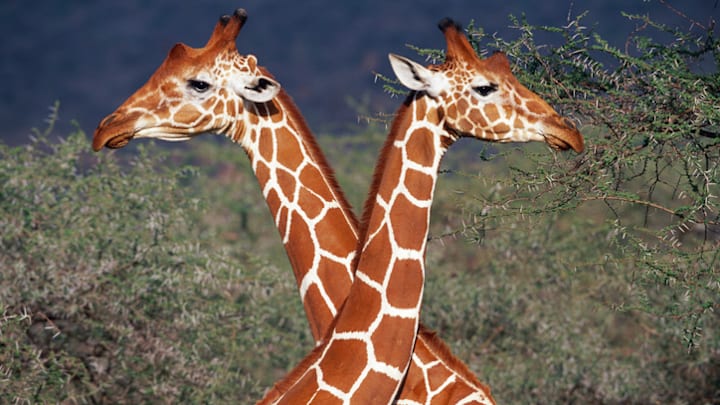You know giraffes are tall—the tallest mammals in the world, in fact—but you may not be aware of these 20 other amazing facts about the leggy herbivores.
1. Giraffes can sprint.
Over short distances, giraffes can run at speeds up to 35 mph. That’s about as fast as a grizzly bear.
2. Giraffes can go a couple of days without drinking water.
They get most of their water from their diet of leaves, seed pods, and bark from the acacia tree—which is good considering their height makes the process of drinking difficult. They need to widen their front legs to reach water at ground level, rendering them vulnerable to lions and other predators.
3. Female giraffes often return to where they were born to give birth.

Aww, heartwarming. But once there, their calves receive a rough welcome into the world. Giraffes give birth standing up, so their babies end up falling over 5 feet to the ground.
4. Baby giraffes recover quickly.
The little ones can stand up and even run within a hour of being born.
5. Giraffes’ tongues can be up to 20 inches long.
They are also dark purple, which is thought to help protect them from sun exposure, and prehensile, which assists in plucking leaves from extra-high branches (or zookeepers’ hands).
6. Giraffes sleep standing up.
As with leaning down for a drink of water, lying down to sleep is difficult for giraffes and makes them easy targets for predators. Giraffes usually stay upright while sleeping, and if they do settle into a vulnerable position on the ground, it’s just for a quick six-minute nap.
7. Their “horns” are technically not horns.

Both make and female giraffes have ossicones, which are hair-covered protrusions from their skulls. Only males use them (for fighting each other).
8. Giraffes require over 75 pounds of food a day.
Their diet of small leaves and twigs means they spend most of their time eating.
9. There are four species of giraffe in the genus Giraffa.
Until 2016, scientists believed there was only one species of giraffe, Giraffa camelopardalis (the second word refers to the ancient Greeks’ opinion that giraffes looked like camels wearing leopards’ coats.) But that year, a study in the journal Nature clarified that there are actually four genetically distinct species that live in different regions of Africa and don’t interbreed: the northern giraffe (G. camelopardalis), southern giraffe (G. giraffa), Masai giraffe (G. tippelskirchi), and reticulated giraffe (G. reticulata). To make things more confusing, the northern giraffe has a subspecies, the Nubian giraffe, whose scientific name is G. camelopardalis camelopardalis.
10. Giraffes have the same number of neck vertebrae as humans.

Giraffes have seven neck vertebrae, like humans, but each vertebra is supersized—up to 10 inches long. That’s what gives them their elongated necks.
11. Giraffes have huge hearts.
Because of their unusual physique, giraffes have a complex cardiovascular system that starts with an enormous heart. It’s 2 feet long and can weigh up to 25 pounds.
12. Their jugular veins are highly specialized.
The veins contain a series of one-way valves that prevent excess blood flow to the brain when the giraffe lowers its head to drink.
13. Male giraffes engage in an elaborate display of dominance.
It’s called necking, and it involves head-butting each other’s bodies.
14. Giraffes walk by moving both legs on the same side of their body together.
So, the left front and hind legs step, and then the right front and hind legs step. Giraffes’ gait differs from horses and most other quadrupeds.
15. Giraffes can fight back when threatened.
Although they’re more likely to run from an attack, giraffes are not completely defenseless. A swift kick from one of their long legs and huge hooves can do serious damage to, or even kill, an unlucky lion.
16. Male giraffes will test a female’s fertility by tasting her urine.
A male giraffe who wants to get busy will try to get a lady giraffe to pee (usually by sniffing her genitals). If she assents, he will place his tongue in the stream of urine, then perform a Flehman response to fully sense the female’s readiness to reproduce.
More Stories About Animals
17. World Giraffe Day is held in June each year.
June 21, to be exact—a date chosen to celebrate the tallest animal on Earth because it’s the longest day (or night, if you’re in the Southern Hemisphere) of the year.
18. Julius Caesar introduced the giraffe to Europe.

The first giraffe to make its way to Europe was brought there by Julius Caesar from Alexandria in 46 BCE as part of a triumphant return to Rome after years of civil war.
19. Lorenzo de’Medici received a giraffe as a gift.
Some 1500 years after Caesar’s giraffe-related activities, Florentine statesman Lorenzo de’ Medici was given a giraffe by the sultan of Egypt. Giraffes had not been seen in Italy since antiquity, and it caused quite a sensation, wandering the streets of Florence and accepting treats offered out of second-story windows.
20. Giraffes’ closest living relative is the okapi.

The only other species in the family Giraffidae is the okapi (Okapia johnstoni), a shy herbivore that lives among thick rainforests in central Africa and has a much shorter neck. It also lacks the distinctive giraffe-print coat, though the okapi’s hind legs are striped horizontally in zebra-like fashion.
A version of this story was published in 2014; it has been updated for 2024.
